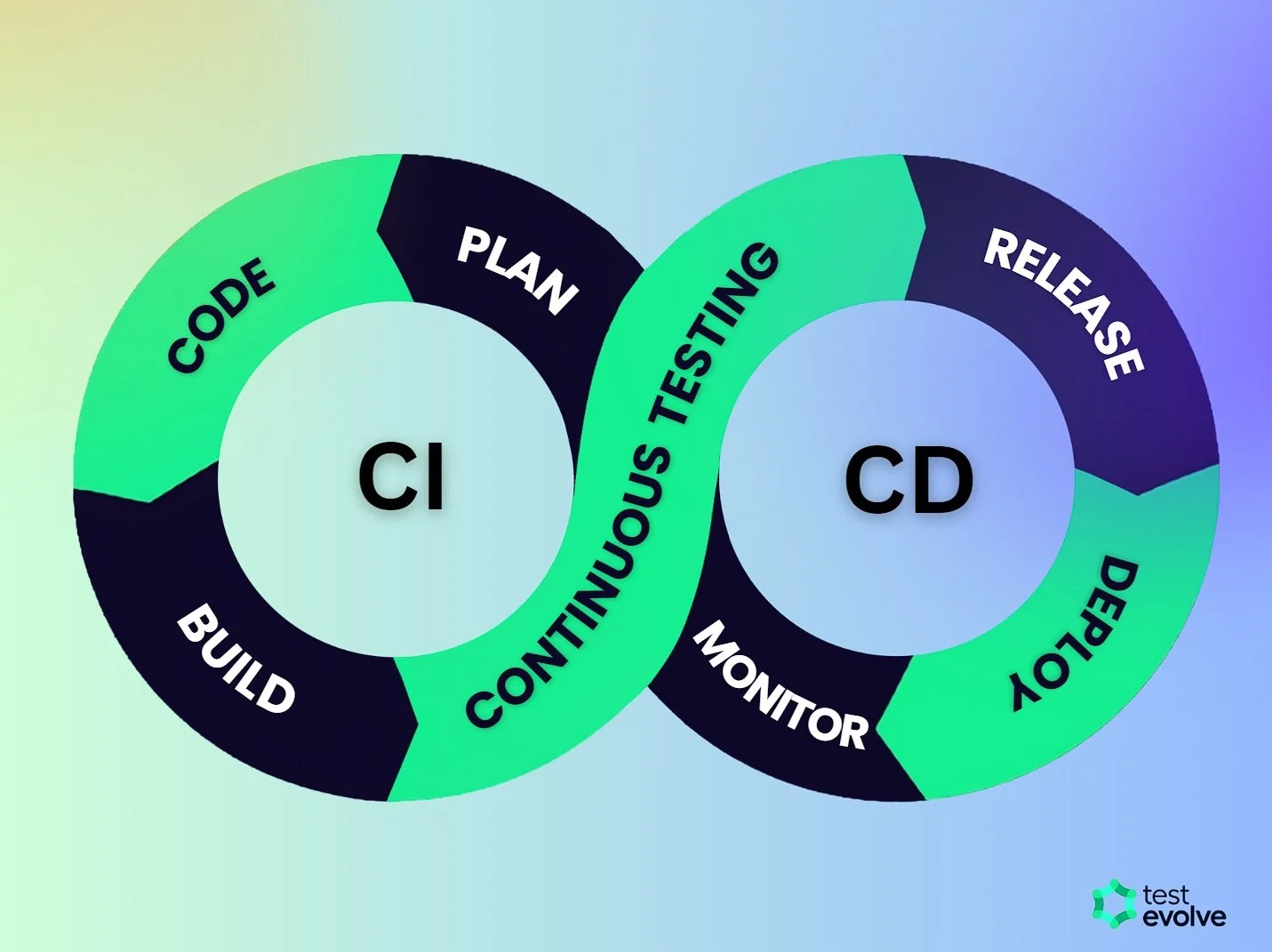What is a CI/CD Pipeline in Software Delivery?
In today's fast-paced world of software development, the importance of reliable delivery pipelines cannot be overstated.
CI/CD pipelines automate the integration of code changes, app creation, testing, and software deployment to live environments.
This blog will cover CI and CD concepts, their history, pipeline steps, the importance of test automation, best practices, and popular tools and applications used in this process.
What is a CI/CD Pipeline?
A CI/CD Pipeline comprises automated procedures that empower developers to release code updates swiftly and with confidence. It encompasses Continuous Integration (CI) and Continuous Delivery (CD). CI focuses on frequently integrating code changes into a shared repository, while CD ensures the product remains in a release-ready state.
Automating these processes accelerates feature delivery to end users and minimizes errors.
Continuous Integration: What is it?
Continuous Integration (CI) emerged in the early 2000s as a response to the challenges of manual software integration and testing in complex projects.
CI addresses the difficulties of integrating changes from various developers by promoting regular integration of code into a central repository. It utilises version control tools like Git and automated build systems for code compilation and testing. The goal is to detect integration issues early and maintain codebase stability throughout development."
The steps of the CI pipeline:
Code Compilation: The first step in the CI pipeline is to compile the code to make sure it is free of errors and ready for execution.
Unit testing: Unit tests are run after compilation to verify the functionality of individual components and identify any faults or regressions.
Integration testing: After the unit tests are successful, the code is integrated and tested in a controlled setting to make sure that various parts function properly
Code analysis: To check for code quality, security flaws and compliance with coding standards, static code analysis techniques are utilized.
Artifact Generation: The CI Pipeline creates deployable artifacts that are ready for deployment, such as executable files or container images.
Failure in any of these processes suggests a potential problem in the codebase, which the developers must fix before moving on.
How has Continuous Delivery, which focuses on automating the release process, emerged as an extension of CI?
Continuous Delivery (CD) has evolved as an extension of CI, focusing on automating the release process. Traditional software releases involved intensive coordination among development, testing, and operations teams, often leading to manual and error-prone work. CD aims to expedite this process by automating deployment environments, provisioning, and configuration management.
What is Continuous Delivery?
Continuous Delivery (CD) is the process of making sure the software can be released to production reliably and whenever it is needed. It entails automating processes that go beyond continuous integration (CI) including handling configuration changes, deploying the application to various environments and conducting integration and end-to-end tests.
Teams are able to quickly roll out new features and upgrades to users because of CD's guarantee that the software is always in a release ready state.
The first step in CD is deployment automation: CD pipelines automate the deployment process to provide reliable deployments to various environments, including development, testing, staging and production
Configuration management: To ensure consistency across many deployment environments. The CD comprises managing configuration files and environment specific settings
Automated testing: To verify the behaviors of the application in multiple environments, CD pipelines run a variety of tests, including integration tests, acceptance tests, and performance tests. These tests aid in finding any problems or regressions that might have been introduced throughout the development process.
Release Orchestration: CD pipelines give teams a way to organize and manage the release of new features and upgrades, giving them control over the timing and manner of software deployment.
Continuous Monitoring: CD comprises tracking the performance of the application in live situations to ovarian user feedback, spot any problems and make data-driven decisions for future enhancements.
CI/CD Workflow Pipeline
The CI/CD workflow pipeline is made up of a number of co-operative processes that provide quick and effective delivery of software. These elements consists of:
Version control systems: Tools like Git act as a central change management tool for storing and maintaining source code, facilitating collaboration and keeping track of changes
Build system: The build system assembles executable artifacts or containers that are prepared for deployment by compiling the code, handling dependencies and resolving conflicts
Testing frameworks: to build and run automated tests including unit, integration tests and end-to-end, to verify the functionality of the product. Testing frameworks like JUnit, Test Evolve’s FLARE or Selenium are utilized.
Deployment automation: By automating the deployment process, solutions like Jenkins, CircleCL, or GitLab CI/CD ensure dependable and consistent deployment across many environments
Environment management and configuration are handled by tools like Ansible, Puppet or Kubernetes, ensuring consistency and reproducibility
Monitoring and Feedback Monitoring technologies like Prometheus or ELK Stack give visibility into the functionality available and behavior of the application in production, allowing teams to solicit feedback and make informed decisions.
Test automation is crucial for CI/CD:
Test automation is essential to the effectiveness of CI/CD processes. Teams may quickly and frequently run tests, detecting regressions or defects that have been introduced by code changes.
Automation of testing allows developers to identify problems early in the development cycle, saving time and resources on troubleshooting and fixing errors.
By expanding the coverage and providing faster feedback loops, test automation also enhances software quality overall and speeds up release cycles.
Best Practices for CI/CD Pipelines
1. Design a comprehensive pipeline
Develop a comprehensive CI/CD pipeline with automated code compilation, testing, deployment and monitoring. Integrate each phase to ensure a smooth workflow. The automated pipeline reduces errors, promotes collaboration and enables rapid iteration. It enhances productivity, accelerates time to market and ensures high quality software delivery.
2. Protect your CI/CD systems
Implementing strong security measures can protect your CI/CD systems from the ongoing threat of unauthorized access and harmful attacks.
Create a multi layered protection approach that includes intrusion detection systems, firewalls, authentication methods and encryption.
Maintain the integrity and confidentiality of your software development pipeline by routinely monitoring and updating security policies to keep ahead of new threats.
3. Run tests early in the process
It is crucial to run tests as soon as they are practical and early in the pipeline to guarantee the proper operation of any system or piece of software. This method enables more effective debugging by proactively identifying and correcting errors at the earliest stage possible, thus saving important time and effort
4. Run tests locally
Before committing changes to the shared repository, it is imperative to run a number of tests locally. This technique has various advantages for the development process. You may considerably lower the possibility of introducing bugs that could potentially cause the build for other team members to fail by taking the time to thoroughly test your code on your local environment.
For the purpose of accelerating the software development and delivery process, CI/CD pipelines are essential. The integration, testing and deployment of code changes may all be automated, which enables teams to produce more frequent and dependable releases.
The success of CI/CD pipelines results in higher productivity, code quality and customer satisfaction. These factors together with the implementation of test automation, adherence to best practices and use of appropriate tools and technologies, all contribute to this success. Understanding Continuous Integration and Continuous Delivery, their origins and the procedures involved in each pipeline are crucial.
Continuous Integration emphasizes routine code integration and automated testing to find problems quickly and keep a codebase stable. Code compilation, unit testing, integration testing, code analysis and artifact generation are all tasks within the CI pipeline. If any of these processes are unsuccessful, there may be problems that require immediate attention.
By automating the release procedure, Continuous Delivery expands CI and makes sure that software is constantly in a release ready state. Configuration management, automated testing, release orchestration and continuous monitoring are all aspects of CD. Teams can now provide new features and updates with confidence and speed.
Version control, build systems, testing frameworks, deployment automation, configuration management, and monitoring tools are just a few of the parts that make up the CI/CD workflow pipeline. For new code to proceed smoothly from development to production, each aspect is essential.
A critical component of CI/CD pipelines is test automation. The team may run tests fast and frequently, assuring the software’s quality and stability. By automating tests, developers and testers may shorten the debugging process, find errors faster, and expedite the release cycle.
It’s critical to adhere to best practices when implementing CI/CD pipelines. The recommended approaches include building a thorough pipeline that includes all required phases, safeguarding CI/CD systems, running tests early and running some tests locally. These procedures aid in delivering software that is dependable and effective.
Conclusion
CI/CD pipelines are now crucial in the delivery of modern software. They allow teams to produce high quality software efficiently and consistently. Successful CI/CD implementations increase productivity, teamwork and customer happiness by utilizing the right tools, the right concepts and by adhering to industry accepted best practices.




